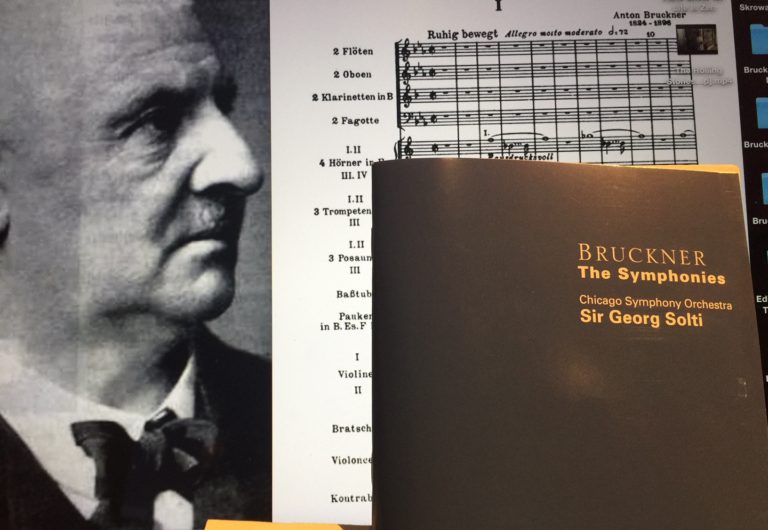 This morning’s conductor of Anton Bruckner’s Symphony No. 4 in E Flat Major (WAB 104), titled “Romantic” by Bruckner himself, is Hungarian-born Sir Georg Solti (1912-1997), an artist with a long and noteworthy career.
This morning’s conductor of Anton Bruckner’s Symphony No. 4 in E Flat Major (WAB 104), titled “Romantic” by Bruckner himself, is Hungarian-born Sir Georg Solti (1912-1997), an artist with a long and noteworthy career.
I provided a lengthy bio of Sir Georg on Day 46 of my 144-day exploration.
If you want to know about this fascinating conductor, I suggest you start there.
 I first heard Sir Georg Solti on Day 14. Then again on Day 30. Then again on the aforementioned Day 46.
I first heard Sir Georg Solti on Day 14. Then again on Day 30. Then again on the aforementioned Day 46.
Today marks the fourth time I’m listening to Maestro Solti.
Before I get into the nuts and bolts, I really need to say that I wish some of these record labels would think through their box sets.
Take Solti’s set, for example. (Since it’s right in front of me I figured – hey! why not?)
If I remove the CD booklet (liner notes) from the box (as I did this morning when I brought the booklet with me to a local restaurant), there’s no way of knowing who published this music. It’s a 56-page booklet with not one label logo or even name on it. None that I can see, at least. And I’m actively looking. Say this booklet gets separated from the box set, as it did this morning. Somebody picks it up, reads it, digs it…and then what? How would he/she know how to re-connected this booklet with the Solti box set from which it came?
Doubt me?
Okay. Here’s a picture of the front of the Solti booklet (I propped it up in front of my laptop’s desktop images of Bruckner and Symphony No. 4):

Here’s a picture of the back of the solti booklet:

Here’s a picture of the inside spread of the Solti booklet:

Do you see any mention of Decca/London?
I didn’t think so.
I looked all through the CD booklet.
I couldn’t find the Decca/London logo or name anywhere. Not once.
Why?
Don’t Decca/London want people to know who published this booklet?
This is the same kind of sloppiness that results in having no liner notes at all, or – and especially – not listing the version the conductor chose, which this booklet also omits most of the time.
That grates my cheese, man.
People who really dig Bruckner, by and large, want to know the version the conductor used. It matters.
So, record labels, if you’re reading this, can you spend more time with the words in your booklets from now on?
Thank you.
Subjective rant over.
Back to the nuts and bolts:
Bruckner’s Symphony No. 4 in E Flat Major composed in 1874
Sir Georg Solti conducts
Solti used the ???? version, edited by Nowak (Which year? Which version?)
Chicago Symphony Orchestra plays
The symphony clocks in at 63:07
This was recorded in January of 1981 at Orchestra Hall in Chicago USA
Solti was 69 when he conducted it
Bruckner was 50 when he composed it
This recording was released on the Decca/London label (but you’ve never know it from the booklet)
Bruckner wrote his symphonies in four parts. The time breakdown of this one (Symphony No. 4 in E Flat Major, version unknown), from this particular conductor (Solti) and this particular orchestra (Chicago Symphony Orchestra) is as follows:
I. Bewegt, nicht zu schnell (With motion, not too fast) (E-flat major)…………..17:57
II. Andante, quasi allegretto (C minor)…………………………………………………………14:44
III. Scherzo. Bewegt (With motion) – Trio: Nicht zu schnell (Not too fast) (B-flat major)……………………………………………………………………………………………………………..7:00
IV. Finale: Bewegt, doch nicht zu schnell (With motion, but not too fast) (E-flat major)………………………………………………………………………………………………………………13:57
Total running time: 63:07
Okay. Now for the subjective stuff…
My Rating:
Recording quality: 4
Overall musicianship: 4
CD liner notes: 4 (extensive essays about Bruckner and his symphonic style in German, French, English, and what appears to be Portuguese – however, no mention of the record label anywhere in its 56 pages, nor is there adequate information about the version used. Which version isn’t usually mentioned.)
How does this make me feel: 3
I notice that I judge Bruckner’s Fourth Symphony by three things:
1. The tone of the horns and the tempo of the opening (first 1-2 minutes) of Movement I
2. Movement III (Scherzo) and the “Hunt” motif (does it invigorate me?)
3. The final moments of the Finale (in this case, from 17:28 onward)
If the opening horn grabs me, if the Scherzo stirs me, if the Finale makes me hinge on each note until the last…
…I can shout “Huzzah!” and feel satisfied by my listening experience.
In this case…
Not so much.
Whatever it is that makes those three moments special to me were not really evident in this recording. Again – to my ears.
Others listening to this may have starting shouting “Huzzah!” from the first :60 of Movement I and didn’t stop until the last :60 of the Finale.
Music is, by and large, in the ear of the beholder.
I could tell this was well played. But it was a bit brassy in some parts…and a bit predictable in others. I wasn’t feeling the magic.
Your mileage may vary.
